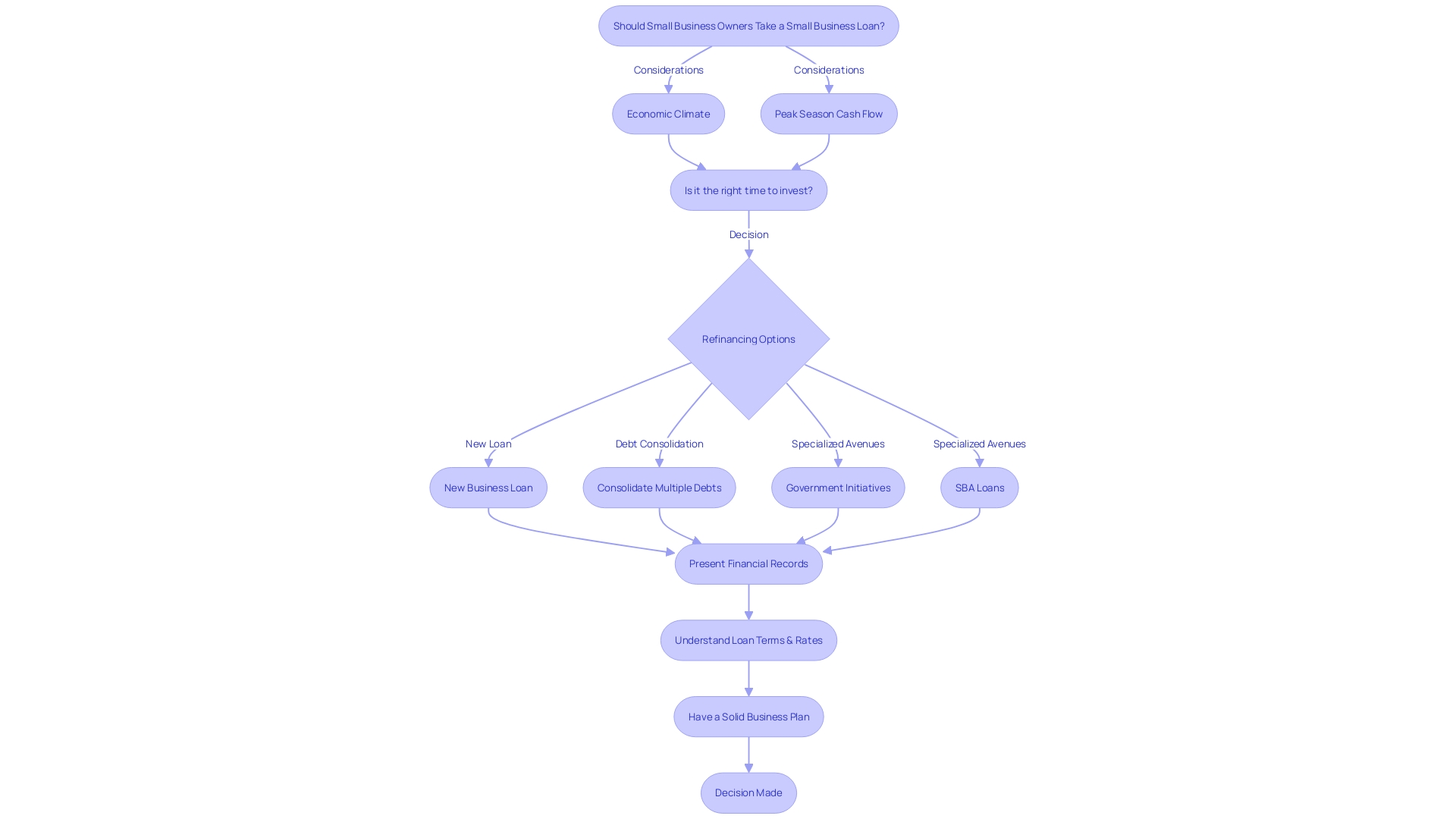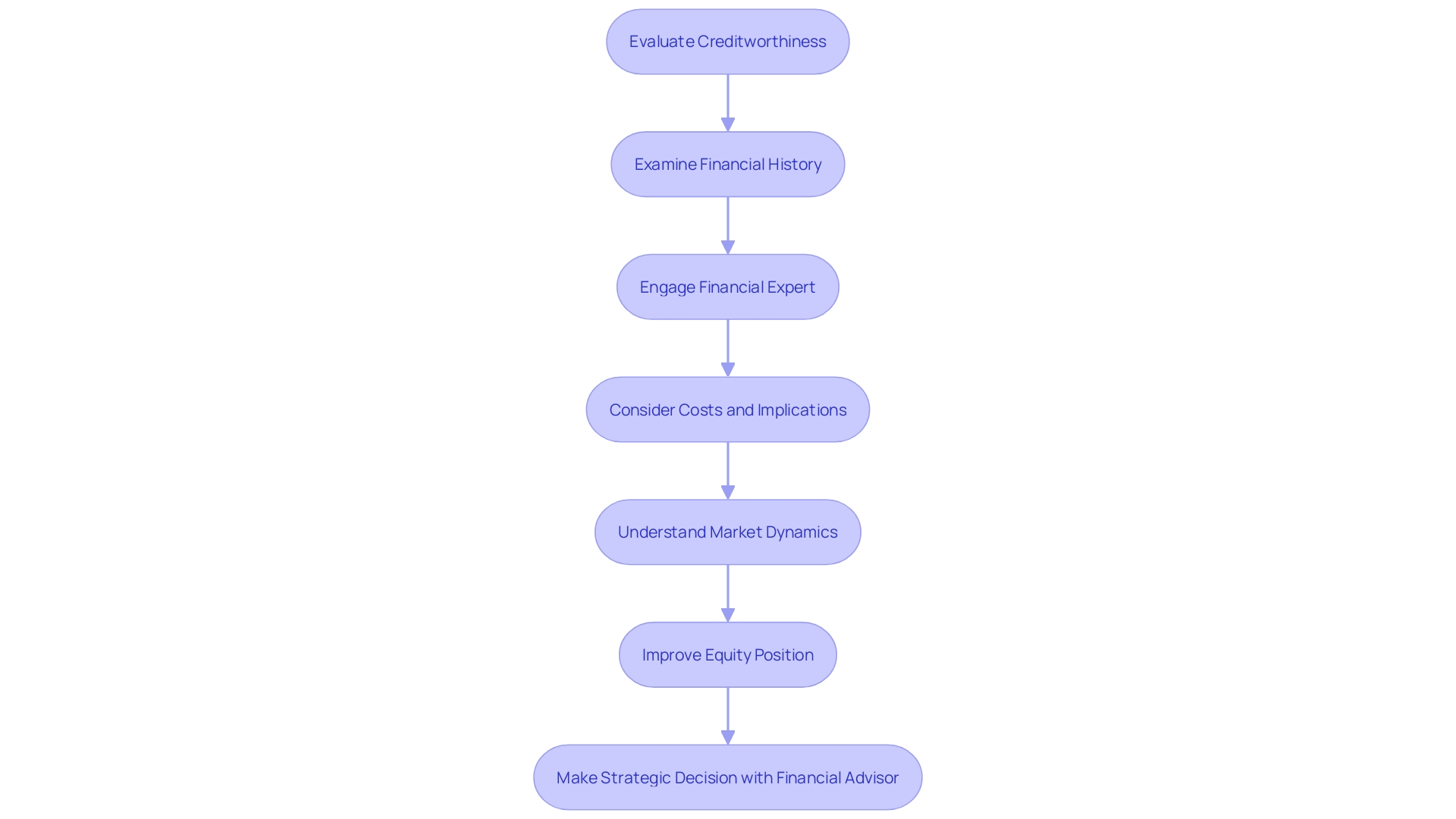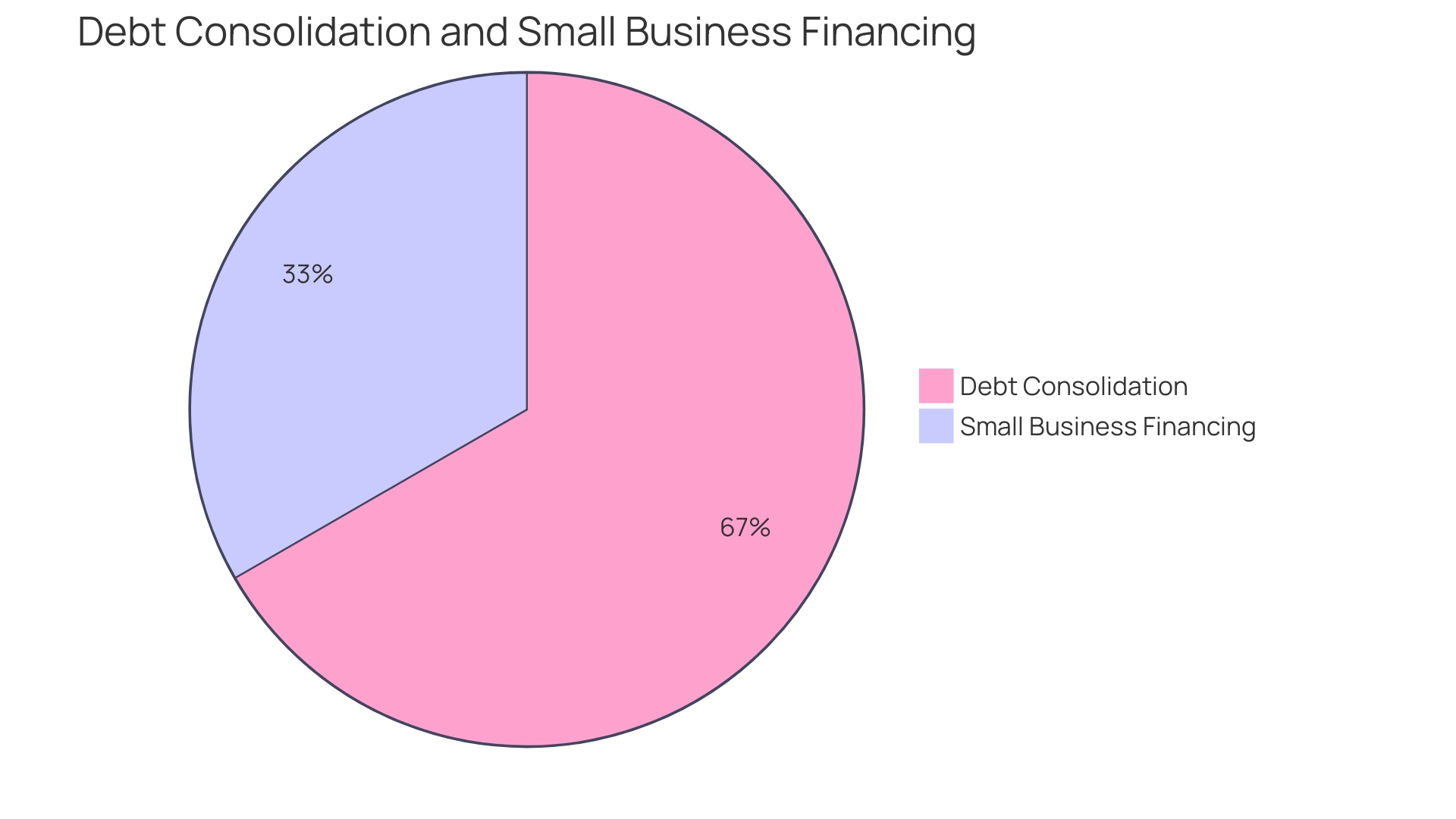Introduction
Refinancing business debt can be a strategic move for small businesses looking to enhance financial agility and growth potential. By analyzing your current debt structure, including loans, credit lines, and credit card obligations, you can identify opportunities for restructuring and consolidation. Debt consolidation, merging multiple debts into a single loan, can simplify payments and reduce interest rates.
With non-bank lenders offering competitive rates, it's crucial to stay updated on financing trends. However, before refinancing, consider if the new loan terms truly offer lower interest rates or extended repayment periods. Timing is key, as refinancing is most beneficial when prevailing market interest rates are lower than your current rates.
Evaluating eligibility, comparing lenders and loan terms, and understanding the potential drawbacks are essential steps in the refinancing process. By strategically managing your new loan, you can pave the way for financial stability and business growth.
Understanding Your Current Debt Structure
Refinancing business debt can be a shrewd move for small businesses seeking financial agility. With a granular analysis of your existing debt profile—comprising loans, credit lines, and credit card obligations—you can pinpoint opportunities for restructuring. This exercise is not just about assessing interest rates, but also about understanding repayment schedules and monthly financial commitments. For instance, a business saddled with high-rate debts, similar to the case of subprime auto loan borrowers paying rates as steep as 22.05%, could significantly benefit from consolidation into a single loan with more favorable terms. Debt consolidation, a strategy where multiple debts are merged into one loan, has gained traction for its potential to simplify payments and reduce interest rates. This tactic aligns with the trends observed where non-bank lenders are offering competitive rates, challenging traditional banking options. Moreover, as seen in the business landscape, organizations like Citigroup Inc. and Goldman Sachs Group Inc. are actively adapting their credit strategies, which underscores the importance of staying abreast with financing trends. When exploring business debt consolidation, consider if the new loan terms truly offer a lower interest rate or extended repayment period, as these factors are pivotal to the consolidation's efficacy. As businesses navigate through the complexities of debt management, it is essential to remember that the ultimate goal is to secure a position that supports steady cash flow and business growth.
Benefits of Debt Refinancing
Small businesses often seek avenues to improve their financial flexibility and growth potential, and debt refinancing is a strategy that can help achieve these goals. The process involves replacing existing debt with a new loan, typically at a lower interest rate, which can result in considerable cost savings over time. This saving can be redirected towards proactive business investments or enhancing operational efficiencies.
Moreover, debt refinancing can streamline financial management by consolidating various debts into a singular loan. This consolidation simplifies the repayment process, making it easier for small business owners to monitor cash flow and manage financial commitments, thus providing peace of mind and allowing them to focus on core business functions. The decision to refinance should be timed strategically, taking into account the economic environment and the specific circumstances of the business.
A practical example of strategic financial management can be seen in the hospitality industry, where location and market understanding are leveraged to drive sales and growth. For instance, a well-positioned hotel in a city center might adopt a multi-disciplinary approach to attract more diners to its restaurant, ultimately boosting food and beverage sales. Similarly, small businesses can apply strategic refinancing to optimize their financial structures based on market conditions.
Small business owners must weigh the decision to refinance carefully, considering factors such as the right investment time and the business’s current economic climate. With a variety of lending options available, including online lenders, banks, credit unions, and peer-to-peer lending sites, finding the right financing solution is crucial for long-term success. Whether it's to launch, sustain, or expand, a well-structured business loan can be a pivotal tool for achieving a company's objectives.
When to Refinance Business Debt
Refinancing business debt effectively hinges on timing and an in-depth understanding of market dynamics. A prime moment to consider this financial maneuver is when the prevailing market interest rates dip below what your business is currently shouldering. This can unlock the potential for reduced interest payments. Moreover, improvements in your business's credit standing or a track record of consistent revenue escalation could open doors to more advantageous loan conditions. It's also crucial to keep a pulse on your cash flow; if debt obligations are suffocating it, refinancing could be a strategic move to alleviate monthly burdens and enhance operational agility.
Navigating the intricacies of business loans, which come with their unique set of repayment schedules and interest rates, demands a discerning eye. Whether you're securing a loan from a bank, credit union, or an alternative lender, it's vital to understand the implications of different loan types on your business's financial health. As with any significant decision, assessing the economic landscape for your industry and determining the optimal timing for investment can be pivotal. Small business owners must weigh these factors carefully to ensure that the choice to refinance aligns with their long-term strategic objectives and the current economic context.
Steps to Refinance Business Debt
To navigate the complexities of business debt refinancing, a meticulous and informed approach is paramount. Initial steps include a thorough evaluation of your existing debt obligations and financial status. This groundwork is crucial for understanding the intricate details of your debt structure and overall fiscal health. As you proceed, researching and scrutinizing various lenders and their loan offerings is essential. Consider pivotal factors like interest rates, repayment terms, and associated fees, along with lender-specific eligibility criteria. A case in point is the surge in issuance of bonds backed by subprime auto loans, highlighting the necessity for careful consideration of loan terms.
Once you've homed in on an appropriate lender, the preparation of key documents is next – including but not limited to financial statements, tax records, and a robust business plan. A comprehensive business plan should articulate your company's mission, targets, and strategies for market engagement and growth. Submitting a thorough and precise loan application enhances the likelihood of its acceptance.
Upon approval, the closing phase entails the execution of the loan agreement and the subsequent disbursement of funds to settle existing debts. The recent increase in mortgage refinance applications, despite rising rates, underscores the importance of timing and market conditions in the refinancing process.
Concludingly, establishing a strategic framework for managing the new loan is imperative. This involves ensuring timely payments and continuous monitoring of your business's financial trajectory. An example of strategic financial management is the transformational case of a global asset manager who achieved streamlined risk reporting and portfolio analytics with a tailored investor-centric solution. This anecdote serves as a reminder of the importance of agility and adaptability in financial planning.
In summary, business debt refinancing is a multifaceted endeavor that demands careful planning, comparison of potential lenders, meticulous documentation, and strategic management post-refinancing. With these practices, businesses can secure more favorable terms, paving the way for financial stability and growth.
Considerations Before Refinancing
When contemplating the refinancing of business debt, it's crucial to conduct a thorough analysis of all associated costs, including origination fees, closing expenses, and any penalties for early repayment of current obligations. These expenses must be measured against the anticipated savings from refinancing to ascertain its financial soundness. Moreover, the potential short-term impact on your credit rating cannot be overlooked, as the application for new credit may result in a temporary decrease in your score. Furthermore, it's imperative to deliberate on the long-term outcomes such as the total interest to be paid throughout the loan's duration and its effects on your business's cash flow. For instance, in the case of subprime auto bonds and borrowers like Janice Siler, the substantial interest rate led to a challenging financial situation despite other sources of income, underscoring the importance of considering the long-term commitment when refinancing. Similarly, business owners must be vigilant about the current economic climate, evaluating whether it's an opportune moment to invest in their business, especially when the finance landscape is shifting, as seen with changes in non-bank interest rates and the treatment of BNPL products in personal finance data. Such foresight is essential for making informed decisions that align with both the immediate and future financial trajectories of the business.
Types of Refinancing Options
When small businesses consider refinancing, they have an array of strategies at their disposal. Opting for a new loan with different lenders can lead to better terms, such as reduced interest rates or extended repayment timelines. Debt consolidation is another route, where various loans are merged into one, streamlining debt management and potentially decreasing monthly outlays. Small businesses should also explore specialized refinancing avenues like government initiatives or SBA loans, which are crafted to bolster small enterprises with distinct advantages. Essential in this process is a thorough comparison of options, ensuring the chosen path is in sync with the company's financial objectives. Key elements in this decision-making process include presenting robust financial records to depict creditworthiness, comprehending business loan terminology like terms, rates, and amortization, and ensuring a solid business plan is in place to articulate the company's vision and operational strategy.

Evaluating Your Eligibility for Refinancing
When considering debt refinancing, it's crucial to understand your standing with lenders. They meticulously evaluate your creditworthiness through indicators such as credit score, revenue, profitability, and debt-to-income ratio. A thorough examination of your financial history and credit report will shed light on your refinancing prospects. Positive changes in your business's financial health or an improved credit score since your initial loan could enhance your chances for more advantageous terms.
Engaging a financial expert can provide valuable insights during this process. For instance, if you're contemplating a cash-out refinance for home improvements, be mindful of the implications. Freddie Mac notes that refinancing typically incurs costs around $5,000, which may deplete the cash you receive. Moreover, with a new loan comes a new rate and potentially higher monthly payments, which must be carefully considered.
In the current financial climate, as highlighted by the October 2023 Senior Loan Officer Opinion Survey, banks have tightened lending standards for commercial and residential loans, making it a challenging time for some to refinance. Nevertheless, understanding these market dynamics and preparing your finances can position you to seize opportunities as they arise. For example, homeowners with adequate equity may find refinancing to be a viable option, despite high mortgage rates. By paying down your mortgage or using a personal loan, you may improve your equity position, thereby meeting refinancing requirements.
In summary, refinancing requires a strategic approach, considering both potential benefits and costs. A financial advisor can assist in navigating this complex process, ensuring that any decision aligns with your long-term financial objectives.

Comparing Lenders and Loan Terms
To optimize your business's financial health, meticulously evaluating debt refinancing options is paramount. Thoroughly investigate various financiers, including mainstream banks, digital lending platforms, member-owned credit unions, and initiatives backed by government support, to gauge their unique offerings and standing in the market. Key considerations should include the interest rates, associated loan fees, the flexibility of repayment options, and the lender's track record as reflected in customer testimonials.
Secure proposals from a diverse range of lenders and scrutinize the fine print of each proposal. The interest rate demands particular attention, as even marginal differences can have a profound effect on the overall cost of borrowing. In your selection, prioritize a lender and loan conditions that are most conducive to your enterprise's fiscal objectives and capacity to repay.
Remember, a strategic approach to debt restructuring can be a critical factor in sustaining and growing your business. Whether you're looking to reduce monthly payments, lower interest rates, or change the term of your loan, it's important to find a solution that aligns with your business's needs and goals. By doing so, you can improve cash flow, invest in growth opportunities, and build a stronger, more resilient financial foundation for your company.

Common Drawbacks to Consider
Refinancing business debt can streamline finances and potentially lower interest rates, but it's not without its challenges. When considering refinancing, small business owners must weigh the immediate financial relief against potential long-term costs. For instance, refinancing could incur various fees—origination charges, closing expenses, and penalties for early payment. These additional costs can add up, and they should be meticulously evaluated against the anticipated savings from a new loan arrangement.
Moreover, while refinancing might offer lower monthly payments, it often extends the debt's lifetime, which could mean paying more interest cumulatively. It's a delicate balance to ensure that refinancing's short-term gains do not lead to long-term financial strain.
Exploring all avenues is crucial; sometimes, unconventional methods like personal bootstrapping or bartering, as exemplified by entrepreneurs who have successfully traded services, may be more advantageous. It's also essential to consider various funding sources, such as friends, family, or even merging or selling the business, before taking the refinancing route.
The decision to refinance should be made with careful consideration of both the current economic climate and your business's specific needs. With business bankruptcies, particularly Chapter 11 filings, seeing a significant increase, it's imperative to consider whether refinancing could help avoid such drastic measures. Should refinancing seem a viable option, understanding the types of available loans, their repayment terms, and the qualifications they require can guide you towards a decision that aligns with your business's financial strategy and growth objectives.
Conclusion
Refinancing business debt is a strategic move for small businesses seeking financial agility and growth. By analyzing your current debt structure, identifying consolidation opportunities, and staying updated on financing trends, you can pave the way for stability. Timing is crucial, as refinancing is most beneficial when market interest rates are lower.
To navigate refinancing complexities, evaluate eligibility, compare lenders and terms, and understand potential drawbacks. Thoroughly assess costs and long-term outcomes on cash flow and interest payments.
When considering options, compare lenders and choose a solution aligned with your business's needs. Ensure timely payments and monitor your financial trajectory.
Before refinancing, evaluate eligibility and understand implications. Seek guidance from a financial expert. Consider short-term credit impacts and long-term commitment.
While refinancing streamlines finances and lowers rates, weigh immediate relief against long-term costs. Explore funding alternatives. Consider economic climate and business needs.
In summary, refinancing demands planning, lender comparison, documentation, and strategic management. Follow these steps to secure favorable terms, paving the way for stability and growth.




